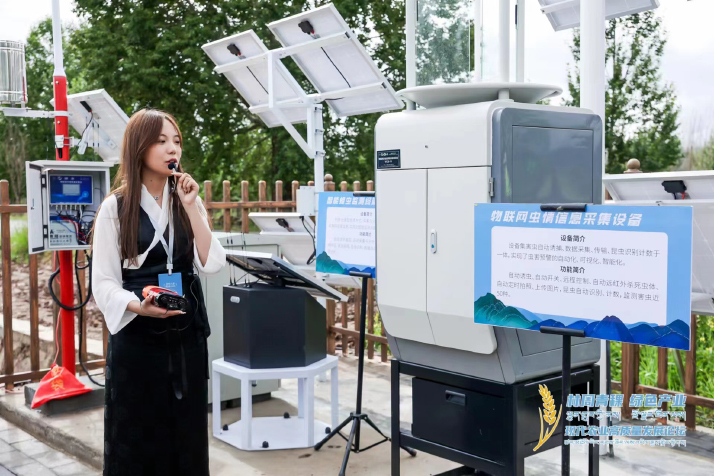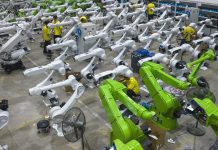Spring plowing in Xizang Autonomous Region started on March 16 this year. Wearing their holiday best, the farmers in Qabgar Village of Lhunzhub County in the regional capital of Lhasa, gathered in their vast highland barley field for the annual ceremony.
This year’s spring plowing is especially promising for Qabgar’s farmers as their field has been included in a pilot zone for smart agriculture.

Smart farming
Last July, the 46.7-hectare field was turned into a pilot zone and outfitted with Internet of Things (IoT) monitoring devices and an integrated system for irrigation and fertilizer application, which make farming more efficient.
According to Basang Cuomu, chief of the Bureau of Agriculture and Rural Affairs of Lhunzhub County, the IoT devices in Qabgar monitor seedlings and soil moisture, detect pests and collect weather information automatically. The integrated system combines irrigation with fertilizer application by adding liquid fertilizers into the drip irrigation system, which helps maintain good soil structure in the field.
“The technologies reduce the water needed for irrigation by 30 percent and labor by 30 to 40 percent,” Basang Cuomu told Beijing Review.
Lhunzhub has long been the granary of Lhasa and modernizing its agriculture sector has been high on the county’s agenda. Two years ago, the county began attaching GPS trackers to the more than 8,000 yaks raised by the herders of Lhakhang Village.
When residents release their yaks to graze in the wild, some always get lost on the vast plateau. “In the past, it would take several days to find lost yaks,” Dawa, a resident of Lhakhang, said.
Raising yaks often requires all family members to engage in pastoral activities and prevents them from taking on other forms of employment, limiting their sources of income.
In July 2021, the village invited Lhasa Jingtu Digital Economy Industrial Group Co. Ltd. to develop a smart yak management platform. Ten months later, the system was put into operation. The GPS tags worn by the yaks allow herders to monitor their locations and trajectories using a mobile app. The system also sends alerts to herders when their yaks are lost or attacked by wild animals.
“If a yak is lost, it now only takes half an hour to find it. The system is very convenient and we no longer need to engage the whole family in herding,” said Dawa.

Digital economy
The smart farming system and yak management platform are examples of Xizang’s development of the digital economy in recent years. According to the white paper CPC (Communist Party of China) Policies on the Governance of Xizang in the New Era: Approach and Achievements, which was released by China’s State Council Information Office in November 2023, the added value of Xizang’s digital economy increased by more than 10 percent in 2022.
According to the Xizang Autonomous Region Digital Economy Development Plan (2020-25), by 2025, the scale of Xizang’s digital economy is expected to exceed 60 billion yuan ($8.34 billion), and the added value of the digital economy is expected to reach 28 billion yuan ($3.89 billion), with an average annual growth rate of over 10 percent.
The growth of the digital economy in Xizang is based on remarkable progress in building digital infrastructure. According to the aforementioned white paper, the region’s e-government websites, unified basic cloud platform and big data control center are largely complete. It has built its first cloud computing center and received the title of national green data center. A total of 8,099 5G base stations and nearly 312,600 km of fiber-optic cables have been installed. 5G networks now cover all counties, districts, main towns and townships in Xizang. Modern cloud and network integration enables locals to connect with the world online.
Alongside their use in the farming sector, digital technologies are also being widely applied in community governance, healthcare, public transportation, and education on the plateau.
China proposed “promoting the rapid growth of the digital economy” in 2017. Since then, the digital economy has become a key driver for China’s green transformation and economic growth.
“The development of the digital economy provides strong impetus and a solid foundation for the development of new quality productive forces, which will in turn drive the transformation of digital technology,” Wang Lei, an associate professor of economics at Shandong Normal University, told Beijing Review.
In the larger context of China’s economic development, new quality productive forces signify a shift toward promoting innovation, technological advancement, and high-value-added industries to propel economic growth. This concept is tied to transitioning from traditional manufacturing to a knowledge-based, innovation-driven economy.
Wang has conducted field research in Xizang for years. He believes that the region needs to fully utilize its own resources and preferential policies issued by the Central Government to develop the digital economy.
“Through the extensive application of digital technology in agriculture, healthcare, and senior care, Tibetans will truly feel the benefits brought by new quality productive forces, which will enhance their sense of gain and happiness,” Wang said. –The Daily Mail-Beijing Review news exchange item






